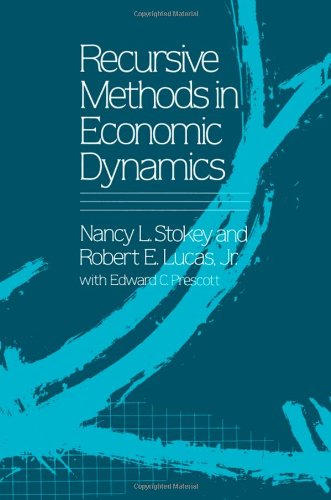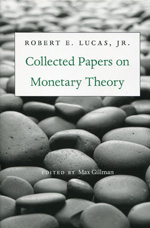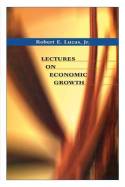Recursive methods in economic dynamics
- ISBN: 9780674750968
- Editorial: Harvard University Press
- Fecha de la edición: 1989
- Lugar de la edición: Cambridge (Mass). Estados Unidos de Norteamérica
- Encuadernación: Cartoné
- Medidas: 24 cm
- Nº Pág.: 588
- Idiomas: Español

Three eminent economists provide in this book a rigorous, self-contained treatment of modern economic dynamics. Nancy L. Stokey, Robert E. Lucas, Jr., and Edward C. Prescott develop the basic methods of recursive analysis and emphasize the many areas where they can usefully be applied.
After presenting an overview of the recursive approach, the authors develop economic applications for deterministic dynamic programming and the stability theory of first-order difference equations. They then treat stochastic dynamic programming and the convergence theory of discrete-time Markov processes, illustrating each with additional economic applications. They also derive a strong law of large numbers for Markov processes. Finally, they present the two fundamental theorems of welfare economics and show how to apply the methods developed earlier to general equilibrium systems.
The authors go on to apply their methods to many areas of economics. Models of firm and industry investment, household consumption behavior, long-run growth, capital accumulation, job search, job matching, inventory behavior, asset pricing, and money demand are among those they use to show how predictions can be made about individual and social behavior. Researchers and graduate students in many areas of economics, both theoretical and applied, will find this book essential.
reface
Symbols Used
I. The Recursive Approach
1. Introduction
2. An Overview
2.1 A Deterministic Model of Optimal Growth
2.2 A Stochastic Model of Optimal Growth
2.3 Competitive Equilibrium Growth
2.4 Conclusions and Plans
II. Deterministic Models
3. Mathematical Preliminaries
3.1 Metric Spaces and Normed Vector Spaces
3.2 The Contraction Mapping Theorem
3.3 The Theorem of the Maximum
4. Dynamic Programming under Certainty
4.1 The Principle of Optimality
4.2 Bounded Returns
4.3 Constant Returns to Scale
4.4 Unbounded Returns
4.5 Euler Equations
5. Applications of Dynamic Programming under Certainty
5.1 The One-Sector Model of Optimal Growth
5.2 A “Cake-Eating” Problem
5.3 Optimal Growth with Linear Utility
5.4 Growth with Technical Progress
5.5 A Tree-Cutting Problem
5.6 Learning by Doing
5.7 Human Capital Accumulation
5.8 Growth with Human Capital
5.9 Investment with Convex Costs
5.10 Investment with Constant Returns
5.11 Recursive Preferences
5.12 Theory of the Consumer with Recursive Preferences
5.13 A Pareto Problem with Recursive Preferences
5.14 An (s, S) Inventory Problem
5.15 The Inventory Problem in Continuous Time
5.16 A Seller with Unknown Demand
5.17 A Consumption-Savings Problem
6. Deterministic Dynamics
6.1 One-Dimensional Examples
6.2 Global Stability: Liapounov Functions
6.3 Linear Systems and Linear Approximations
6.4 Euler Equations
6.5 Applications
III. Stochastic Models
7. Measure Theory and Integration
7.1 Measurable Spaces
7.2 Measures
7.3 Measurable Functions
7.4 Integration
7.5 Product Spaces
7.6 The Monotone Class Lemma
7.7 Conditional Expectation
8. Markov Processes
8.1 Transition Functions
8.2 Probability Measures on Spaces of Sequences
8.3 Iterated Integrals
8.4 Transitions Defined by Stochastic Difference Equations
9. Stochastic Dynamic Programming
9.1 The Principle of Optimality
9.2 Bounded Returns
9.3 Constant Returns to Scale
9.4 Unbounded Returns
9.5 Stochastic Euler Equations
9.6 Policy Functions and Transition Functions
10. Applications of Stochastic Dynamic Programming
10.1 The One-Sector Model of Optimal Growth
10.2 Optimal Growth with Two Capital Goods
10.3 Optimal Growth with Many Goods
10.4 Industry Investment under Uncertainty
10.5 Production and Inventory Accumulation
10.6 Asset Prices in an Exchange Economy
10.7 A Model of Search Unemployment
10.8 The Dynamics of the Search Model
10.9 Variations on the Search Model
10.10 A Model of Job Matching
10.11 Job Matching and Unemployment
11. Strong Convergence of Markov Processes
11.1 Markov Chains
11.2 Convergence Concepts for Measures
11.3 Characterizations of Strong Convergence
11.4 Sufficient Conditions
12. Weak Convergence of Markov Processes
12.1 Characterizations of Weak Convergence
12.2 Distribution Functions
12.3 Weak Convergence of Distribution Functions
12.4 Monotone Markov Processes
12.5 Dependence of the Invariant Measure on a Parameter
12.6 A Loose End
13. Applications of Convergence Results for Markov Processes
13.1 A Discrete-Space (s, S) Inventory Problem
13.2 A Continuous-State (s, S) Process
13.3 The One-Sector Model of Optimal Growth
13.4 Industry Investment under Uncertainty
13.5 Equilibrium in a Pure Currency Economy
13.6 A Pure Currency Economy with Linear Utility
13.7 A Pure Credit Economy with Linear Utility
13.8 An Equilibrium Search Economy
14. Laws of Large Numbers
14.1 Definitions and Preliminaries
14.2 A Strong Law for Markov Processes
IV. Competitive Equilibrium
15. Pareto Optima and Competitive Equilibria
15.1 Dual Spaces
15.2 The First and Second Welfare Theorems
15.3 Issues in the Choice of a Commodity Space
15.4 Inner Product Representations of Prices
16. Applications of Equilibrium Theory
16.1 A One-Sector Model of Growth under Certainty
16.2 A Many-Sector Model of Stochastic Growth
16.3 An Economy with Sustained Growth
16.4 Industry Investment under Uncertainty
16.5 Truncation: A Generalization
16.6 A Peculiar Example
16.7 An Economy with Many Consumers
17. Fixed-Point Arguments
17.1 An Overlapping-Generations Model
17.2 An Application of the Contraction Mapping Theorem
17.3 The Brouwer Fixed-Point Theorem
17.4 The Schauder Fixed-Point Theorem
17.5 Fixed Points of Monotone Operators
17.6 Partially Observed Shocks
18. Equilibria in Systems with Distortions
18.1 An Indirect Approach
18.2 A Local Approach Based on First-Order Conditions
18.3 A Global Approach Based on First-Order Conditions
References
Index of Theorems










